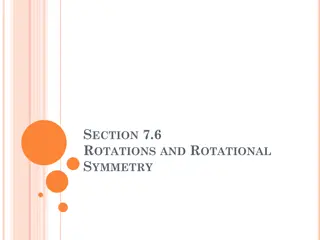symmetry
Biological symmetry plays a fundamental role in the morphology and functionality of organisms. Explore different types of symmetry such as radial, bilateral, and biradial, as well as the significance of asymmetry. Discover how symmetry or its absence influences the spatial arrangement and functional specialization in living beings.
Uploaded on Feb 16, 2025 | 0 Views
Download Presentation

Please find below an Image/Link to download the presentation.
The content on the website is provided AS IS for your information and personal use only. It may not be sold, licensed, or shared on other websites without obtaining consent from the author.If you encounter any issues during the download, it is possible that the publisher has removed the file from their server.
You are allowed to download the files provided on this website for personal or commercial use, subject to the condition that they are used lawfully. All files are the property of their respective owners.
The content on the website is provided AS IS for your information and personal use only. It may not be sold, licensed, or shared on other websites without obtaining consent from the author.
E N D
Presentation Transcript
symmetry Dr.M.Deivanayaki
Biological symmetry can be thought of as a balanced distribution of duplicate body parts or shapes within the body of an organism. ... There are only a few types of symmetry which are possible in body plans. These are radial (cylindrical), bilateral, biradial and spherical symmetry.
Asymmetry is the absence of, or a violation of, symmetry (the property of an object being invariant to a transformation, such as reflection). Symmetry is an important property of both physical and abstract systems and it may be displayed in precise terms or in more aesthetic terms. The absence of or violation of symmetry that are either expected or desired can have important consequences for a system. Asymmetry is an important and widespread trait, having evolved numerous times in many organisms and at many levels of organisation (ranging from individual cells, through organs, to entire body-shapes). Benefits of asymmetry sometimes have to do with improved spatial arrangements, such as the left human lung being smaller, and having one fewer lobes than the right lung to make room for the asymmetrical heart. In other examples, division of function between the right and left half may have been beneficial and has driven the asymmetry to become stronger. Such an explanation is usually given for mammal hand or paw preference (Handedness), an asymmetry in skill development in mammals. Training the neural pathways in a skill with one hand (or paw) may take less effort than doing the same with both hands.
Definition Radial symmetry describes living and non-living forms; these forms can be equally divided into three or more sections that, when rotated through a center of rotation by more than 0 and less than 360 , exactly match each other in orientation and shape. Radial symmetry does not deal with mirror images but near-perfect matches, for example the five equidistant arms of a starfish that circle its central body and are of the same size and shape. Biradial symmetry is found in organisms which show morphological features (internal or external) of both bilateral and radial symmetry. Unlike radially symmetrical organisms which can be divided equally along many planes, biradial organisms can only be cut equally along two planes.
Bilateral Symmetry Definition Bilateral symmetry refers to organisms with body shapes that are mirror images along a midline called the sagittal plane. The internal organs, however, are not necessarily distributed symmetrically.























